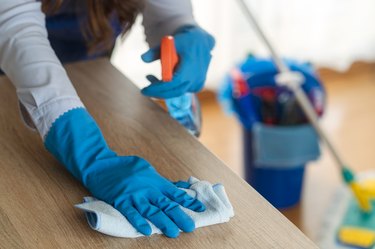
Other than fragrance and color, which are detergent additives that don't clean or disinfect, the active ingredients of detergent soap are the ones that include different components with different modes of action. The reason that different types of cleansing agents are needed is because there are different kinds of soiling agents. For example, one type of cleanser works to remove oily residues, but it may be ineffective on protein stains.
Many laundry detergents also include a disinfecting agent to kill viruses and bacteria. Although many of the ingredients listed on the label of your detergent may have unpronounceable names, each of them performs a specific function.
Video of the Day
Video of the Day
Surfactants in Detergents
Among the active ingredients of detergent soap are those categorized as surfactants. These ingredients remove dirt, oil and grease stains by a chemical action that takes place because of polarity (or magnetic attraction). Surfactants are composed of phospholipids, a class of fats that is attracted to water's polarity, and certain fatty acids, which repel water. The result is that this attracting and repelling action is able to suspend stains, which the water washes away.
You may see surfactants simply listed as "soil suspending agents," as they're noted on the label in the active ingredients of Wings detergent, or you may see surfactants listed by their chemical names, such as "sodium laurel sulfate," "sodium laureth sulfate" or "sodium laurel polyethoxyethanol sulfate," which is listed in the active ingredients of Breeze detergent.
Oxidizing Agents in Detergents
Chlorine bleach (sodium hypochlorite) is not only an effective oxidizing agent and one of the strongest stain removers in detergent but it's also a disinfectant for bacteria and viruses. Examples of oxidizable stains include tea, coffee, red wine and lipstick. Bleach works to remove these stains by breaking the chemical bonds that give color to some organic compounds. When these bonds are broken down, a stain is lighter or no longer visible because the color is shattered into smaller fragments that do not absorb light in the visible spectrum of human vision.
If you've ever bleached an item of clothing, you know that bleach is very effective in removing the color. This feature works great to remove stains on white clothes, but you probably don't want to use chlorine bleach if you're washing colored clothing unless you want to remove the color. As an option to chlorine bleach, some laundry detergent ingredients include a "bleach alternative," which is oxygen bleach (sodium percarbonate). This type of bleach is safe to use on colored clothing because it leaves the colors intact.
When a powdered detergent containing oxygen bleach is dissolved in water, the sodium percarbonate breaks down into sodium carbonate and hydrogen peroxide. It's the hydrogen peroxide that becomes the oxidizing agent that breaks down stains.
Enzymes in Detergents
As proteins, enzymes are comprised of different combinations of amino acids. Each enzyme has an area called its "active site," which interacts with a specific type of molecule called a "substrate." This interaction results in the enzyme's being able to break down the substrate, effectively eliminating stains. Each type of enzyme is substrate-specific; that is, it only works on certain stains.
Common types of enzymes in detergents are amylases, cellulases, lipases and proteases. Because stains are comprised of different substrates, such as lipids and proteins, detergents have different types of enzymes in their active ingredients. You may see the specific enzyme listed on a detergent label, such as amylase in Tide detergent, or you may see the general word "enzyme" on the label.